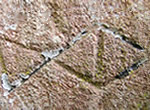Masons' Marks Project
The Archaeology Service started a small project a few years ago to record medieval and later stone masons’ marks on as many churches, castles, bridges etc as possible in the NE of Scotland. We believe this was the first time such a project had been undertaken over such a large area. Because of the scale we felt this was a good opportunity for local heritage groups or societies to become involved in recording part of their own local history. Their local knowledge proved to be an integral part of the project.



That small project has now developed into a far larger ongoing national Masons' Mark Project which we are proud to support and be part of.
Mason’s tended to lead a rather nomadic life, being involved mainly in the building of castles, churches and cathedrals, so they had to travel to where there was employment. One of the aims of this project is to try to see if we can make any sense of them.

Many questions have been asked over the years as to the purpose of masons’ marks, with different views being given depending on which aspect someone has been studying. Was it to mark how many stones he had carved for payment purposes? Was the mark passed down from father to son on his death? If a son was working with his father and was also a master mason, did he use a similar mark but with a small addition? We may not be able to answer all of these questions but at least we hope it may be possible to track a mason’s journey.
We have already had a number of surprises, including recording over 645 marks on two spans of the southern North Water bridge over the River South Esk, and also identifying a particular mark belonging to a particular mason working in 1555 at Kinnaird Castle near Brechin.
